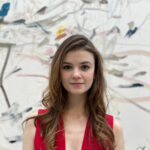ABT and Complexions Swap Classes and Stretch Their Comfort Zones
While American Ballet Theatre and Complexions Contemporary Ballet fall into very different size and repertoire categories, both institutions’ dancers start their day with pliés and tendus—even in quarantine. A ballet class seemed like a natural connection point for a recent teacher swap initiative between the two organizations. Sascha Radetsky, artistic director of ABT Studio Company, and Desmond Richardson, Complexions co-artistic director, led the effort. “Sascha and I were colleagues at ABT and knowing his teaching ability, Dwight [Rhoden, Complexions co-artistic director] and I wanted him to share his expertise with our Summer Intensive students. In turn, I would teach the ABT Studio Company,” Richardson explains.
Richardson kicked off the swap on Zoom in late July, teaching a joint class for the Studio Company, ABT company members and Jacqueline Kennedy Onassis School upper-level students. Barre began with shoulder rolls set to a light percussive track. Flexed feet and contractions that featured throughout barre would deepen into a center combination with gooey rond de jambs, piqués with sweeping V-arms, chugs, inversions and a hip thrust or two.
It was a dynamic deviation from the classical maintenance-focused classes many ABT dancers have been taking during the COVID-19 shutdown.
ABT’s spring season was cancelled at the height of the pandemic in New York City, and its fall season at Lincoln Center’s David H. Koch Theater, slated for October 21—November 1, has also been cancelled over future COVID-19 concerns. As for Complexions, the company’s annual Joyce Theater season had its run last January and February, but its summer tours to Germany and Latvia have been postponed.
Still, spirits and relevés are high as both institutions hold summer intensives and company classes over Zoom. Radetsky saw the swap as a perfect opportunity for adapting to virtual restraints: “I had long hoped Des might teach for ABT Studio Company, but our budget rarely allows for guest teachers,” he says. Former ABT principal Stella Abrera, now artistic director of Kaatsbaan and its affiliated summer intensive (and Radetsky’s wife), also jumped on board. “The three of us worked out a little quid pro quo: Stella and I would each teach a class for Complexions and in exchange, Desmond would teach a class for our respective programs.”
Radetsky, who taught for Complexions’ summer program last week, notes that the teacher swap appealed to more than the Studio Company. “The prospect of a Desmond Richardson master class stirred so much excitement within ABT that we ultimately decided to open it up to the main company and a few of the JKO School’s top students, as well,” he says.

Hannah Foster
Thus, the likes of principal dancer Devon Teuscher, corps member and Co-Lab Dance choreographer Lauren Post and rising star Catherine Hurlin appeared in little squares on the Zoom screen.
Richardson built the final combination over a few phrases like in any contemporary or modern class. He had everyone run through it together a few times before alternately spotlighting the men and women. The screen full of dancers, not exactly in sync, pushed the limits of their respective living rooms or took advantage of empty studios in their socially distanced locations.
Teuscher, who took class outside on a sunny deck, her little black-haired dog popping in and out of frame, loved getting out of her comfort zone. “Generally, the company classes are very square with a lot of focus of technique. It was a challenge to try and learn something new, let alone learn it through Zoom! Learning choreography is such a big part of a dancer’s life so it reminded me that it’s important to keep those brain muscles working,” she says. Teuscher even found an extra benefit through the virtual format: “It was actually quite freeing to be on Zoom and not see myself or other dancers in the mirror.”
Before everyone clapped their thanks and said goodbye, Richardson offered advice he hopes the dancers will carry with them in all future contemporary work. “Make sure you keep using your classicism to liberate you,” he says, “I was so glad when my teachers taught me, when I was training in Vaganova style, not to lose all that I can do.”
As to whether they’ll ever do it again? Richardson would likely say so: “It was a brilliant happening, and we look to future collaborations.”





